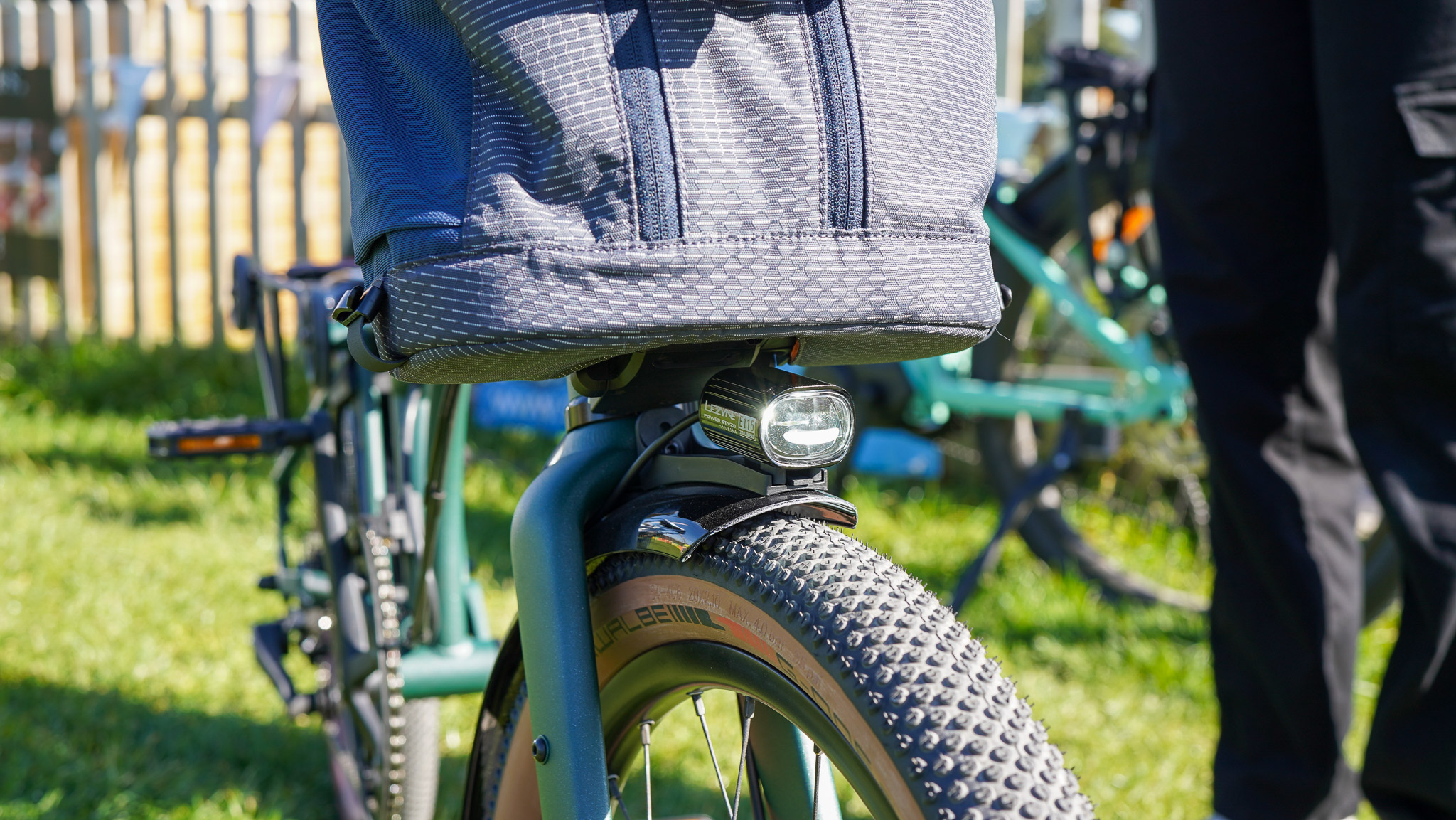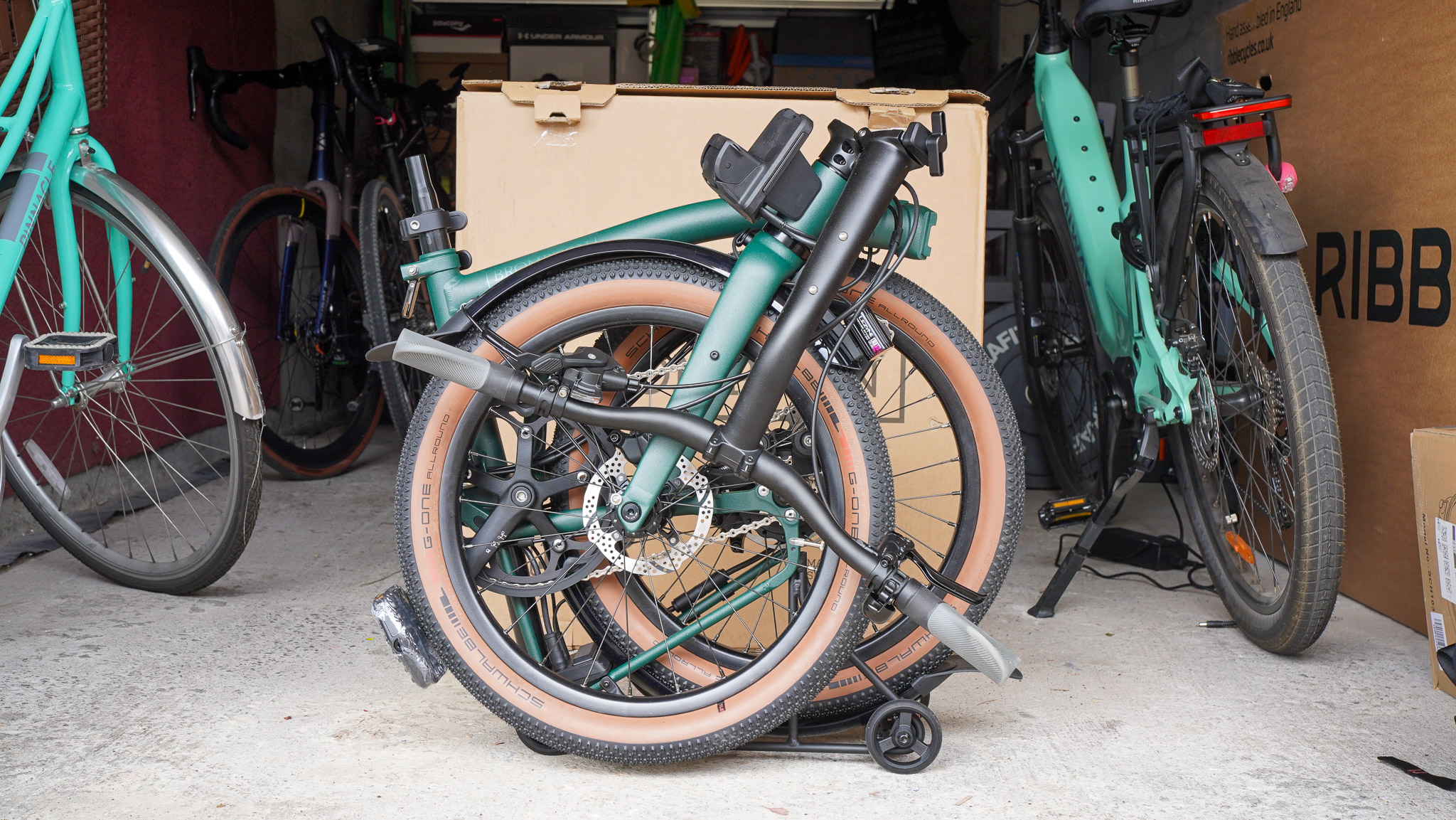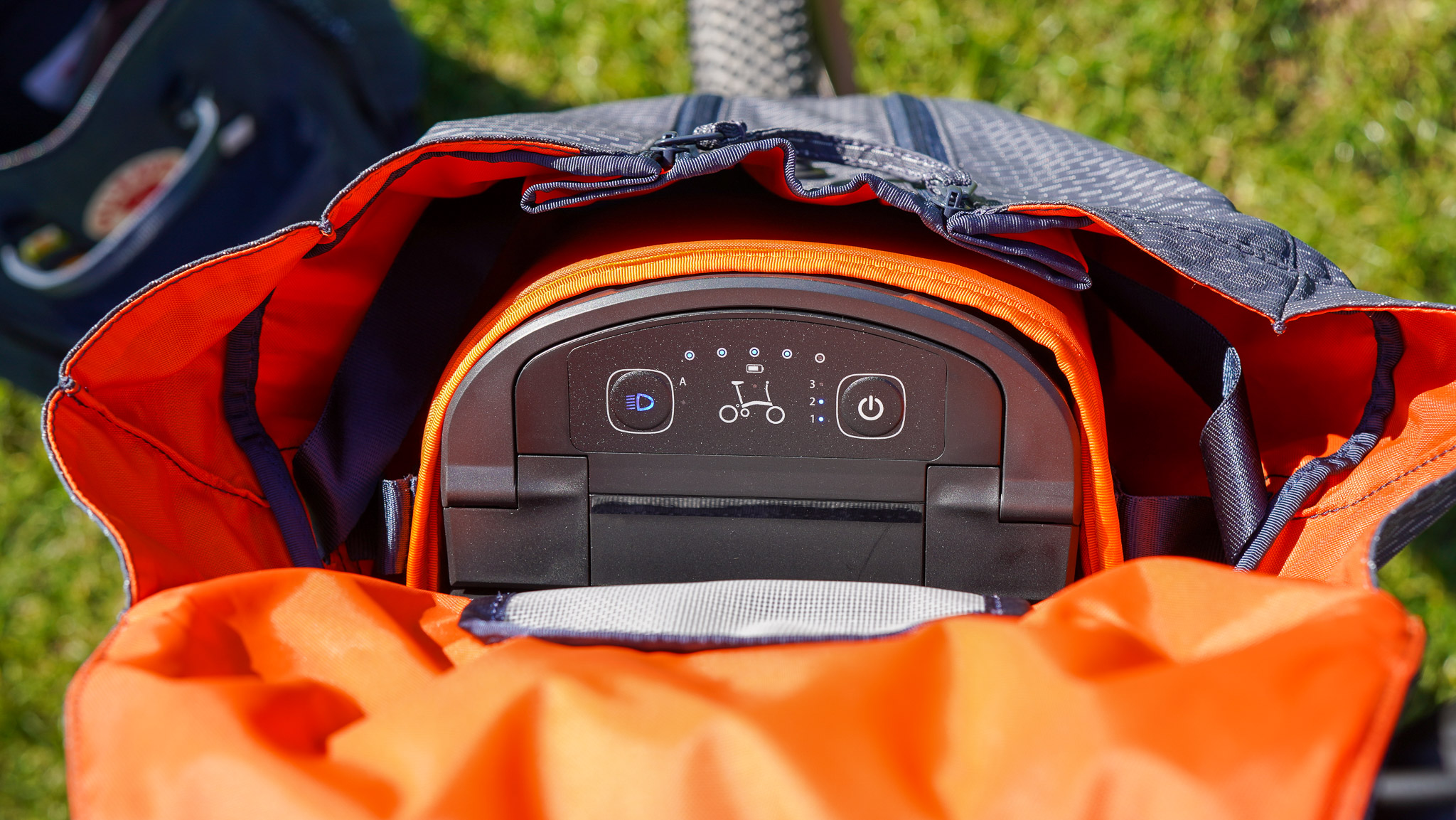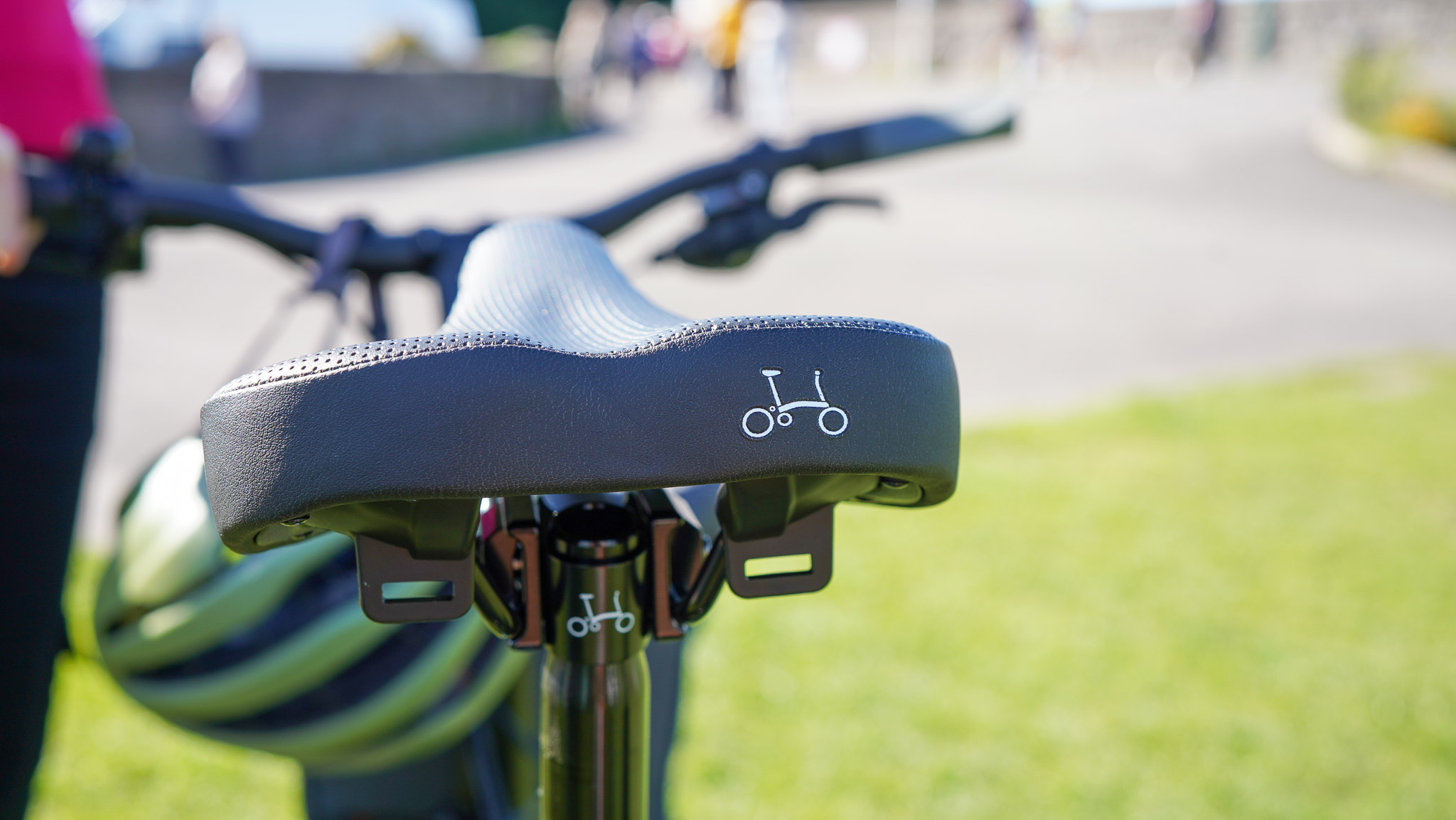Brompton Electric G Line review: Bigger wheels, bigger thrills
With the new Electric G Line, power meets portability in every fold


The Brompton Electric G Line elevates the brand's signature folding bike with larger 20-inch wheels for better off-road performance and a more powerful battery for extended range. With integrated lights, a sleek design, and smooth handling, it's an ideal choice for riders looking for versatility and effortless urban commuting.
-
+
Flawless folding mechanism
-
+
Larger wheels handle off-road excursions better
-
+
Compact design makes it easy to store
-
+
Built-in front and rear lights
-
+
Battery is more powerful than before
-
+
Rides well without the battery pack
-
-
Battery can be temperamental
-
-
Remote control on the handlebar would be ideal…
-
-
… And so would be even a small display
Why you can trust T3

I feel privileged to be one of the few people testing and reviewing the new Electric Brompton G-Line ahead of its launch. The new bike is an important milestone for the brand and also for the industry, which has been struggling somewhat in the last 12 months.
Although it looks and feels like a Brompton, the G-Line has been (re)designed from the ground up to make it better suited for out-of-town excursions. It’s not necessarily an off-road bike, but the 20-inch wheels have better off-road capabilities than the Brompton classic 16-inch variety.
I opted to test the electric version, which, I thought, suited T3 better, us being a technology-oriented publication. Plus, I like riding electric bikes just as much as road bikes, so I thought I might as well check out the revamped battery and all the other trimmings of the Electric G Line.
I’ve been using the bike for the last two weeks, taking it on multiple rides off the beaten track (well, not proper off-roading, but not tarmac, either) to see what the Electric G Line can and can’t handle. Read my full review below to find out whether it's worth the investment!
Brompton Electric G Line review
Price and availability
The Brompton G Line was announced in September 2024 and comes in various configurations and pricing options. The standard G Line 8-Speed starts at 13.9 kg (size Small) and is priced at £2,399 (approx. $3,167/ AU$4,687).
For those who need additional practicality, the G Line 8-Speed with rack and mudguards weighs 14.8 kg and costs £2,499 (approx. $3,298/ AU$4,883). There’s also an option with lights, priced at £2,489, or with both lights and a rack for £2,589.
For riders looking for electric assistance, the (small) Electric G Line 4-Speed weighs 16.1 kg without the battery (or 19.5 kg with the battery attached) and is priced at £3,499 (approx. $4,618/ AU$6,838). All models are available in Forest Green, Adventure Orange, and Traildust White.
Get all the latest news, reviews, deals and buying guides on gorgeous tech, home and active products from the T3 experts
The Brompton G Line will be available starting in October at Brompton Junction stores, selected Brompton Accredited Retailers across the UK and Europe, and online at Brompton.
Specifications
- Weight: 16.1kg (small frame size without battery)
- Folded size (small): 690mm (h) x 730mm (l) x 402mm (w)
- Range: 20-40 miles (32-64 km)
- Charging time: TBC
- Gears: 4
- Power: 250W
Design and build quality

The G Line represents Brompton’s most significant design evolution to date. As Tom Kerr, G Line Design Lead, aptly put it, "[The G Line] is designed to give you that 'big bike' feel while still offering the portability you’d expect from a Brompton."
The most striking change is the introduction of 20-inch wheels, which enable the G Line to handle rougher terrains, such as gravel and forest paths, with ease. These larger wheels, fitted with custom, puncture-resistant, tubeless-ready Schwalbe tyres, necessitated a complete overhaul of the bike’s geometry.
Remarkably, despite its increased size, the G Line retains the familiar ride characteristics of Brompton’s 16-inch models. The expertly engineered frame, with its smooth welds, not only delivers a sleek aesthetic but also ensures robust performance. Every component fits together seamlessly, and the exceptional build quality is immediately evident whether the bike is folded or unfolded.
During a factory visit, I learned that the production process had to be extensively restructured to accommodate the new G Line. Given the bike's many innovations, it’s unsurprising that Brompton had to optimise manufacturing. This transformation was no small feat, especially for a company committed to B-Corp certification, which meant they couldn’t simply outsource production. Every inch of the Brompton factory was already in use before the G Line was conceived, and it required significant effort from all departments to bring the bike to life.

Moving beyond its new wheel size, the G Line also introduces other notable firsts for Brompton, such as hydraulic disc brakes, which provide enhanced stopping power. The bike comes equipped with mudguards and a rear luggage rack as standard, although curiously, it lacks a kickstand. Additionally, the pedals have been upgraded to the brand’s “grippiest, most comfortable” set yet, with a wider design for improved stability.
To ensure better control of the larger frame, the G Line features a wider handlebar. Despite this, the bike feels just as agile and nimble as its smaller counterparts. At the ends of the handlebars are Brompton’s new Ergonomic Grips, designed to offer all-day comfort and support.
The innovations don’t stop there. The G Line’s battery has also been upgraded to 345 watt-hours, offering more power without increasing its physical size. The frame and front carrier block have been redesigned as well. By moving the electronics away from the front carrier block, Brompton has not only improved the bike's durability but also made the battery more secure while maintaining its ease of removal for charging.


One of the G Line’s standout features is its rear-wheel drive—an industry-standard for non-folding e-bikes but a significant achievement for a folding bike. The 250-watt motor, which can peak at 450 watts, powers the Brompton Advance 4-speed system, offering three power modes to assist you as you pedal. The integrated front and rear lights, controlled via the battery pack or the app, provide excellent visibility with a 9-watt beam in the front and a 1-watt light with a reflector at the rear.
Setup

One of the many advantages of the Brompton folding design is that the bike can be shipped pretty much assembled. The Electric G Line comes in a compact box (for a bike), and it’s essentially rideable as soon as you lift it out of the box. One of the pedals is quick-release, and once that’s in place, the bike is unfolded, the seat installed and the battery is charged, you’re ready to go.
The Electric G Line folds just as well as 16-inch Bromptons. I assume many will know how to fold and unfold the bike, but here's a quick explainer for those who don’t.
You first lift the saddle, which releases the rear wheel from its folded position under the bike. Once unlocked, swing the rear wheel down and into place behind the frame, allowing the bike to stand upright on its two wheels. Next, unclip the frame latch by rotating the lever, then swing the front wheel forward until the frame locks securely into position. At this point, the bike is extended, but you still need to prepare the handlebars.
To continue, raise the handlebar by releasing the latch and pulling it up until it clicks firmly into place. Lastly, adjust the pedals. The left pedal, which is foldable, should be extended outward to its riding position. At this point, your Brompton is ready to ride.
Folding the bike back up is just as straightforward. Start by folding the left pedal inward. Then, release the handlebar latch and fold the handlebars down alongside the frame. After that, unlock the frame by rotating the lever and swing the front wheel back towards the rear.
Once the front wheel is tucked in, lift the saddle to trigger the final fold. The rear wheel will automatically swing underneath the bike, locking into position and allowing the bike to stand on its small wheels. At this point, the bike is compactly folded and ready for transport or storage.
I was out testing the bike, and as I was taking pictures of folded Brompton, a guy practically ran over and started explaining to his friend how ‘this bike folds into itself’ and ‘it just flips open like a Swiss Army knife’. To his delight, I popped the Electric G-Line open in about 10 seconds, and needless to say, his brain was blown.
Ride performance

I rode the Electric G Line when I visited Brompton in August, and the brand also very kindly sent over the large version for further testing. I’ve been testing the bicycle for the last two weeks and took it on a few rides to see how it handles mixed-terrain trips.
One of my main objectives was to test the battery. As mentioned above, the Electric G-Line comes with a larger, 345Wh battery, but the range isn’t massive at 20-40 miles. It’s fine for commuting, but day trips are a different ballgame altogether, and the G Line should be able to cope with those, too.
The longest ride I had on the Electric G Line was around 25 miles (approx. 40 km), and the battery went from full to around 40% by the end of the trip. For most of the trip, I was on the first level of assistance, with the occasional level three support when I had some hills to tackle.
Speaking of assist, the Electric G Line requires a pedal turn and a half before it starts applying any motor power. This means that if you’re trying to start cycling on a slant, you will have to pedal harder to get started. Some electric bikes apply assist pretty much as soon as you start turning the pedal – not the Electric G Line, though!

I missed a few convenience features, such as a remote control on the handlebar and maybe even a small display. The Brompton Electric app provides you with a way to control the assist and view your stats, but it’s not as handy as physical buttons you can press. You don’t want to fiddle with the phone when you’re travelling at a speed, do you?
I appreciate that Brompton tried to make the Electric G Line less taxing from the production point of view, and adding a remote and an integrated display would have made the electric version very different from the standard G Line. I get that. Still, for a £3,000+ bike, these small things almost feel necessary.
On the plus side, thanks to the removable battery pack, the Electric G Line can transform into a push bike easily, albeit with half as many gears (the standard G Line comes with an 8-gear derailleur at the back). Convenient when you forget to charge the battery and want to use the bike.
One of my favourite aspects of the Electric G Line is that it handles just as well as smaller Bromptons. Turns are sharp, and the bike rides well in both urban and rural environments. The larger wheels are a real boon when it comes to handling the Electric G Line on rougher terrain, but don’t expect it to replace your mountain bike.
Verdict

The Brompton Electric G Line is a standout addition to the brand’s iconic lineup, offering a near-perfect blend of portability and performance. Its larger 20-inch wheels make it ideal for handling rougher terrain, yet it retains the brand’s flawless folding mechanism, ensuring compactness and ease of storage.
The redesigned frame, paired with a more powerful 345Wh battery, allows for enhanced range and capability, making it a great choice for city commuting and occasional out-of-town rides. The integrated front and rear lights are a welcome addition, adding to the bike’s all-weather, all-terrain versatility.
However, the absence of a handlebar remote and a display feels like a missed opportunity, especially for a bike at this price point. The battery, while powerful, can occasionally be temperamental, but overall, the ride quality remains smooth, even when the electric assist is off.
The G Line is an important launch for the company and the UK’s bike industry. It’s not the perfect electric bike, but it’s a fun ride and has a lot going for it that I’m sure will entice Brompton fans and newcomers alike.
Also consider
Known for its compact fold and powerful Bosch electric system, the Tern Vektron S10 is ideal for urban commutes. It features 20-inch wheels and offers a smooth ride with good battery life.
A sleek, high-tech folding e-bike with integrated lights and app connectivity, the GoCycle G4 is lightweight and balances portability and performance.
The Rad Power Bikes RadExpand 5 is an affordable folding electric bike that offers a great blend of versatility and value. Its fat tires and sturdy frame make it a good choice for both urban and off-road riding.
Dahon Unio E20 combines the brand’s expertise in folding bikes with electric power, offering a reliable and smooth ride with a lightweight design, perfect for commuting.
With a unique folding design and a long-lasting battery, the Fiido X is another solid alternative. It's compact, lightweight, and boasts an impressive range for an electric folder.

Matt Kollat is a journalist and content creator who works for T3.com and its magazine counterpart as an Active Editor. His areas of expertise include wearables, drones, fitness equipment, nutrition and outdoor gear. He joined T3 in 2019. His byline appears in several publications, including Techradar and Fit&Well, and more. Matt also collaborated with other content creators (e.g. Garage Gym Reviews) and judged many awards, such as the European Specialist Sports Nutrition Alliance's ESSNawards. When he isn't working out, running or cycling, you'll find him roaming the countryside and trying out new podcasting and content creation equipment.